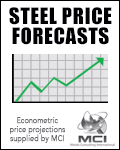Steel Market Report Example - Country XYZ.
Example of single country steel market report
Total Steel
In 2013 total consumption of finished steel in XYZ was 2.5 million tonnes. This compares with total consumption of 2.8m tonnes in 2010, 1.3m tonnes in 2000, 0.8m tonnes in 1990 and 0.2m tonnes in 1980. Consumption in XYZ has been over 2m tonnes per year since 2005.
In 2013 XYZ had total consumption of finished steel per person of 312 kg, compared to a world average of 227 kg. The 'steel intensity' of the economy in 2013 was 16.7 kg per $000 of income per person, compared to the world average of 39.0 kg. The steel intensity of the economy is low because of a small manufacturing sector in XYZ. Total consumption of finished steel is forecast to rise from 2.5m tonnes in 2013 to 2.8m tonnes in 2020 and 3.9m in 2030.
Steel production in XYZ will be affected by the level of domestic consumption, but also by trends in imports and exports of steel products. Total production of hot-rolled steel products is forecast to increase from 450,000 tonnes in 2013 to 560,000 tonnes 2020 and 680,000 tonnes in 2030.
Flat Products
Plate
In 2013 total consumption of steel plate in XYZ was 60,000 tonnes, of which 10,000 tonnes was for production of welded tube and 50,000 tonnes for sale to the market. Consumption of plate is normally about 80,000 tonnes per year and has fluctuated around that level since the 1990. We forecast that demand for steel plate should rise slowly, from 60,000 tonnes in 2013 to 75,000 tonnes in 2020 and 90,000 tonnes in 2030.
In 2013 imports of plate into XYZ accounted for all consumption. Imports are reported as from Switzerland, but data from exporters shows that the main source of imports are Ukraine (50,000 tonnes), Russia (10,000 tonnes) and Itally (10,000 tonnes). We do not expect any production of plate in XYZ, so imports will continued to supply all consumption.
HR Coil
Total consumption of HR coil in XYZ in 2013 is estimated at 250,000 tonnes, of which none was used for cold rolling, 40,000 tonnes were for production of welded tube and the balance of 210,000 tonnes was for sale to the market. We forecast that demand will grow slowly, from 290,000 tonnes in 2013 to 320,000 tonnes in 2020 and 400,000 tonnes in 2030.
In 2013 imports of HR coil into XYZ accounted for all consumption. Imports are reported as from Luxembourg and Switzerland, but data from exporters shows that imports are normally from normally from Russia (100,000 tonnes), Ukraine (50,000 tonnes), Spain (20,000 tonnes), Turkey (20,000 tonnes), France (20,000 tonnes) and Italy (15,000 tonnes) Kazakhstan (350,000 tonnes) and South Korea (200,000 tonnes), with only small quantities from India (30,000 tonnes). We do not expect any production of HR coil in XYZ and all consumption will be supplied by imports.
CR Coil
Total consumption of CR coil in XYZ in 2013 is estimated at 60,000 tonnes, of which none was for galvanising, or tinplate and all was for sale to the market. Imports have been at about this level since 1995. We expect continued slow growth in demand, so that total consumption of CR coil is forecast to increase from 60,000 tonnes in 2013 to 70,000 tonnes in 2020 and 80,000 tonnes in 2030.
In 2013 imports of CR coil into XYZ accounted for all consumption. Data from exporters shows that imports are normally from Russia (10,000 tonnes), Turkey (10,000 tonnes, with smaller quantities from Belgium, France, Germany, Italy, Spain and China. We do not expect any producton of CR coil in XYZ unless the market size increases to a minimum of 100,000 tonnes, so imports will continue to meet all demand.
Galvanised
Total consumption of galvanised coil in XYZ in 2013 is estimated at 400,000 tonnes. This was an exceptionally high leve, as previous consumption was about 280,000 tonnes since 2006. Construction is the main consumer of galvanised in XYZ. Consumption of galvanised is forecast to fall back from the high level of 2013 in the short and recover to 390,000 tonnes in 2020 and 550,000 tonnes in 2030.
In 2013 imports of galvanised coil into XYZ accounted for all consumption. Data from exporters shows that imports are normally from China (180,000 tonnes), Italy (60,000 tonnes) and Turkey (30,000 tonnes). The market in XYZ seems large enough to support local galvanising capacity, but this is not included in our forecasts and all consumption will be supplied by imports, providing a significant market for overseas suppliers.
In this data galvanised coil includes organic coated coil, which is discussed separately in the next section. We estimate that in 2013 consumption of electro-galvanised coil in XYZ was 3,000 tonnes, all supplied by imports, while consumption of hot-dip galvanised was 360,000 tonnes, of which none was further processed to produce organic coated coil or tinplate and all was for sale to the market. Consumption of electro-galvanised neen static since the 1990s.
Organic Coated
Total apparent consumption of organic coated coil in XYZ in 2013 is estimated at 30,000 tonnes. Consumption has risen slowly from 20,000 tonnes in the 1990s. Consumption of organic coated coil in 2013 was 8% of the total consumption of galvanised, but varies from year to year. We expect that the growth of organic coated steady, so that consumption of organic coated is forecast to rise from 30,000 tonnes in 2013 to 60,000 tonnes in 2020 and 100,000 tonnes in 2030.
In 2013 imports of organic coated coil into XYZ accounted for all consumption. Data from exporters shows that imports are normally almost entirely from China. The market in XYZ is not large enough to support domestic production, but may become so by 2030. Until that time all demand will be met by imports.
Other products
The report continues in this format, discussing demand levels, import volumes, main consumption issues and important market trends for flat, long and tubular steel products. [Where iron and steelmaking takes place, this aspect is also discussed in each country report].
Etc, etc, etc...
To contact us about this steel industry market report please email info@steelonthenet.com.








